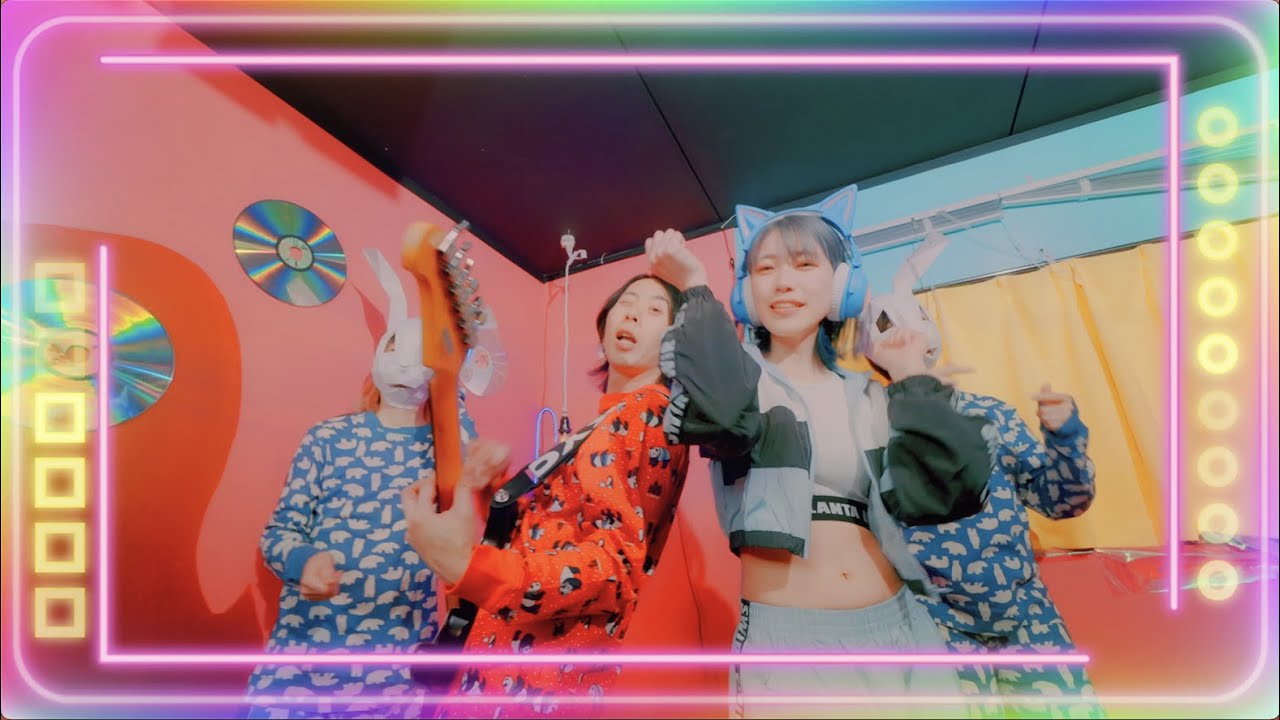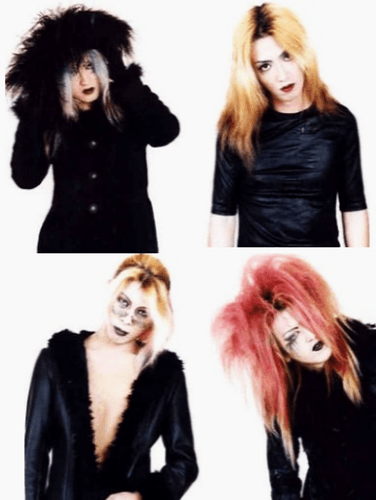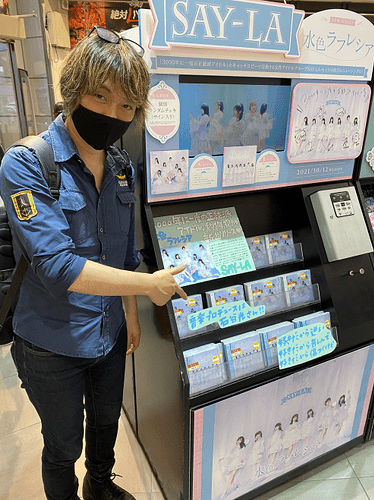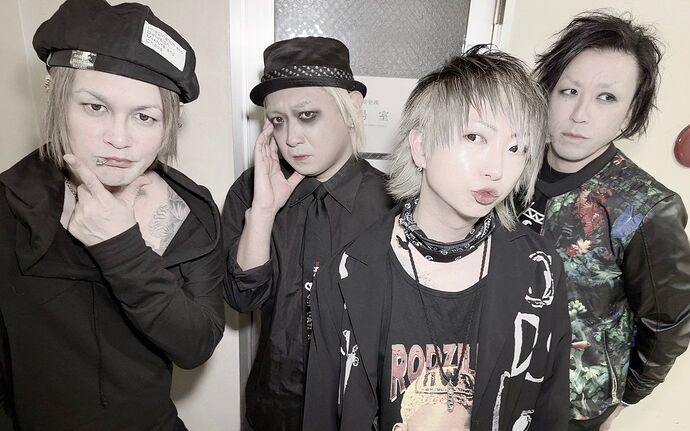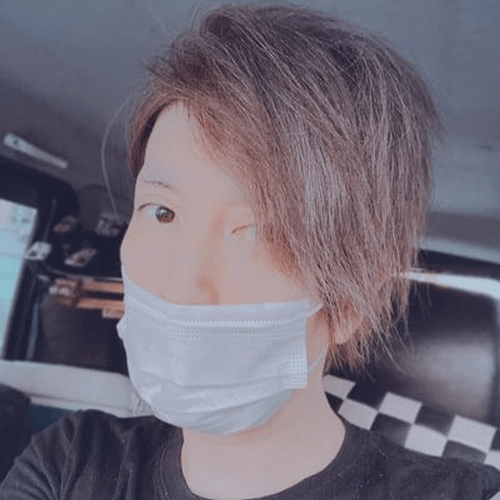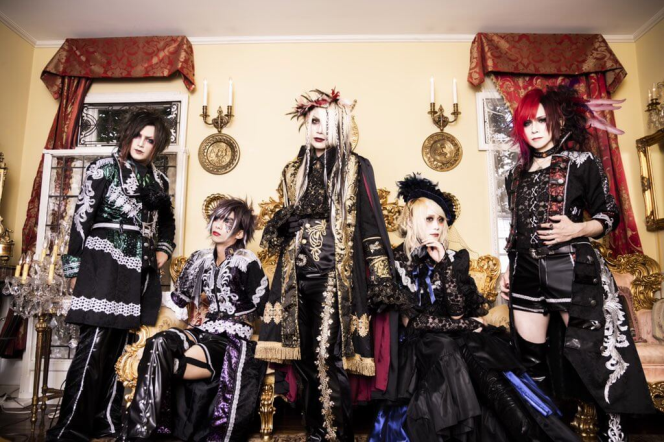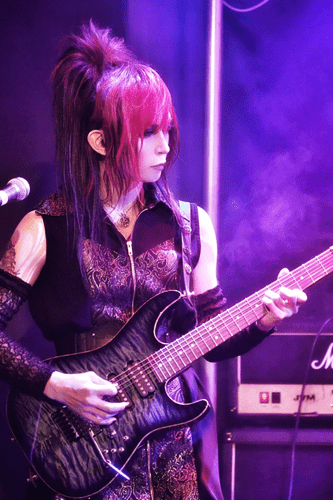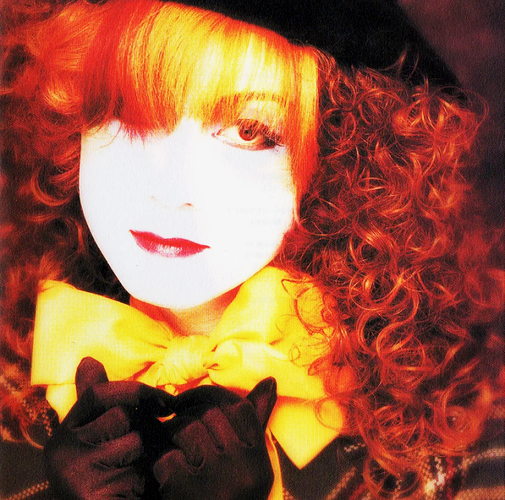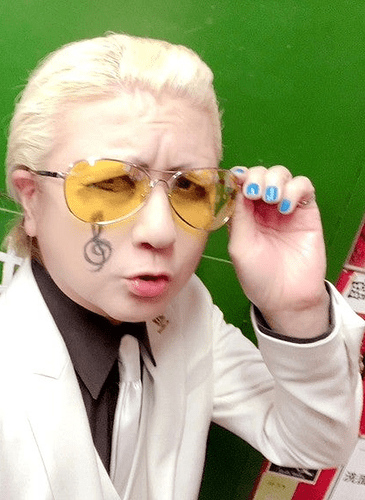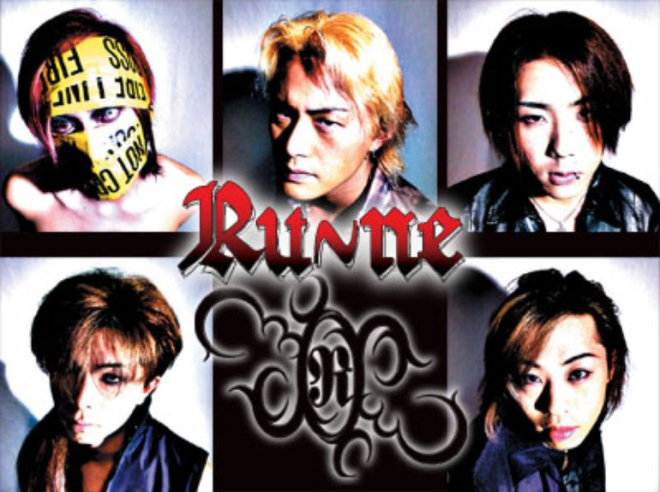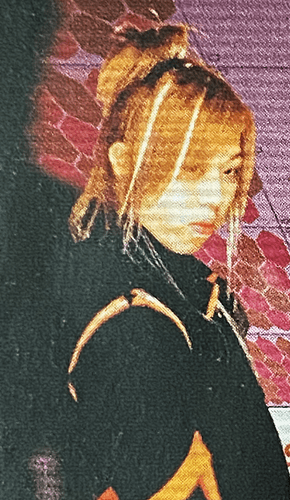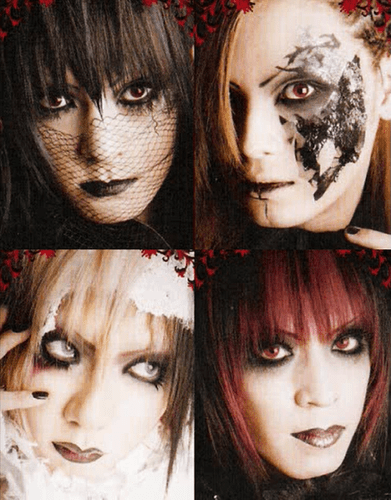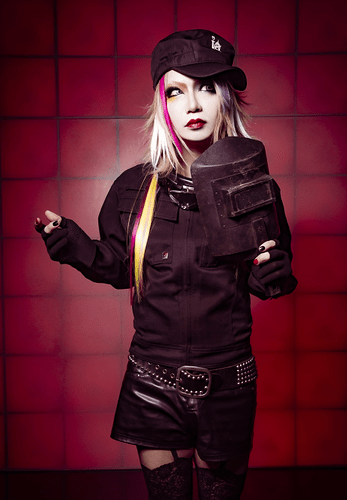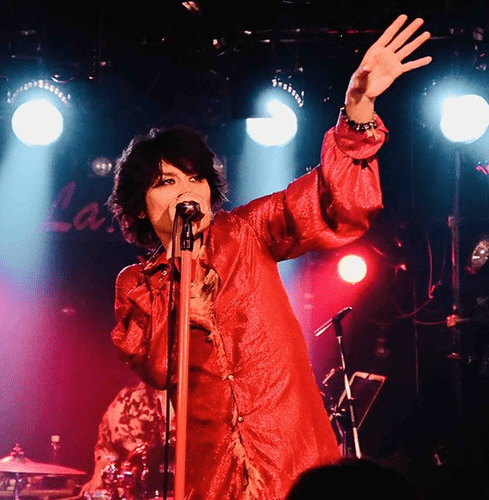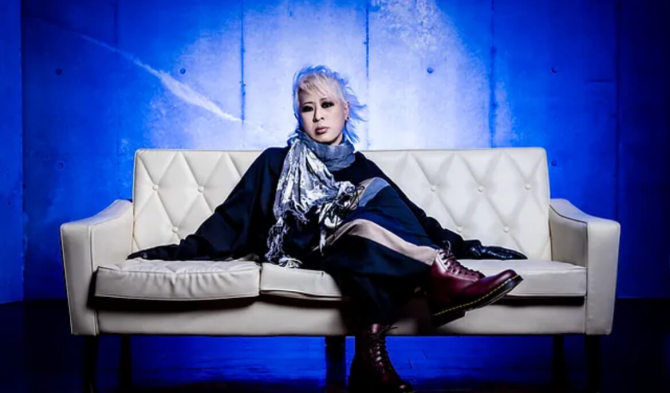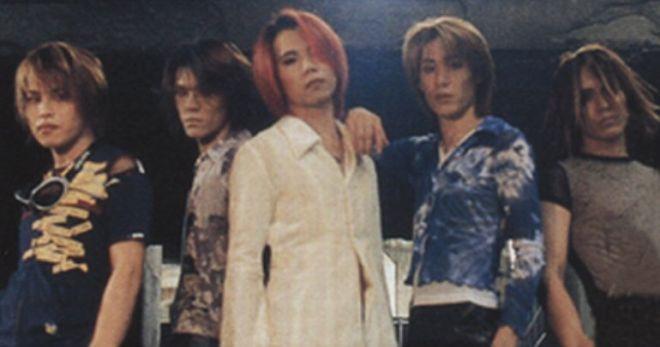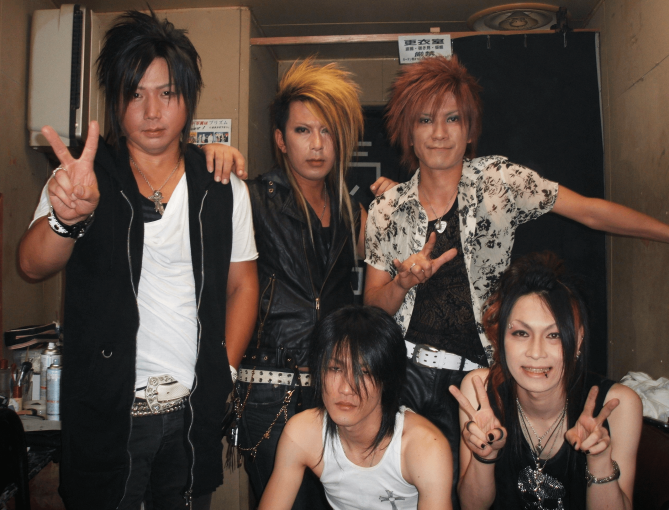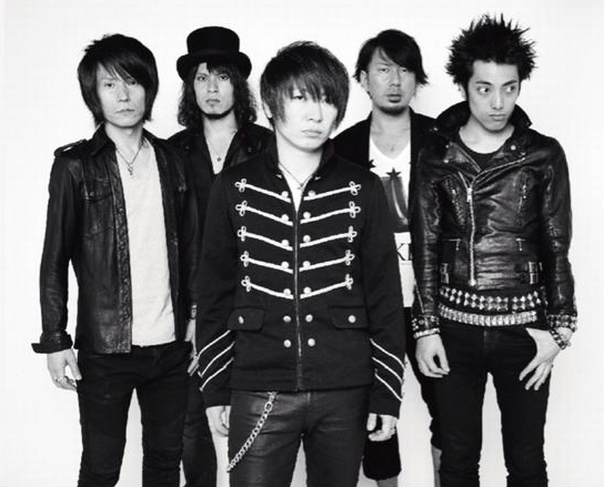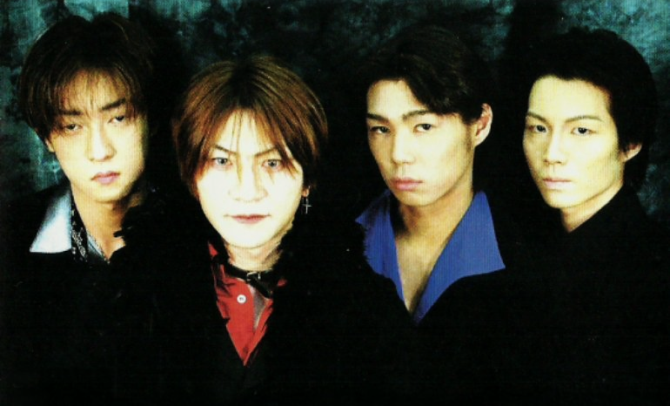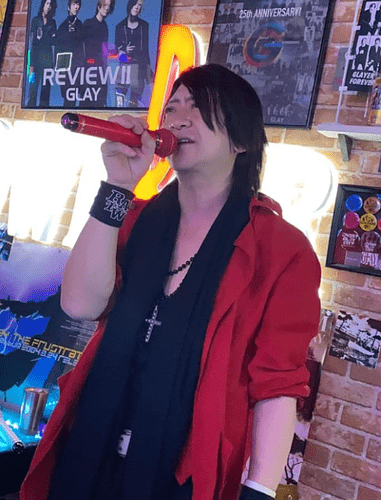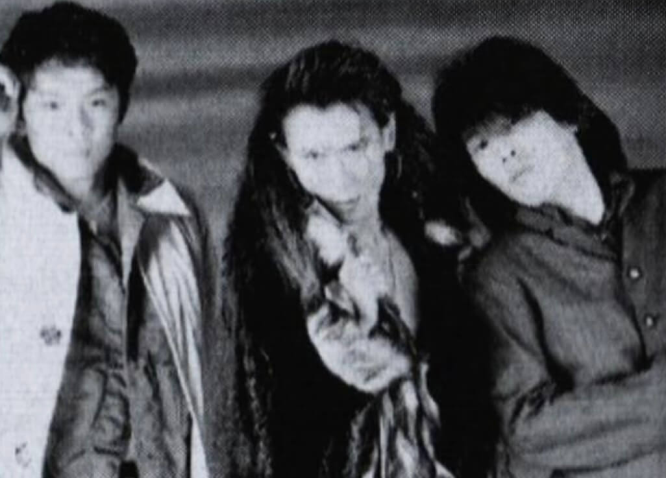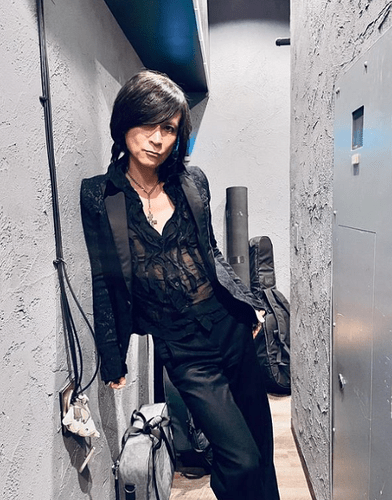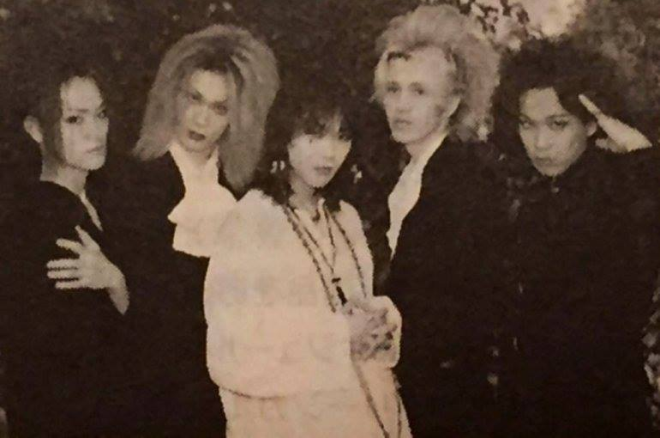#012 - Jun (純)
Famous bands: SEPHILA, 404NOTFOUND
- What first got you interested in visual kei?
- Around the time I started, there was a huge boom in visual kei, so that was how it caught my attention and interest. I then started out as a roadie for ACiD.
- Your first band was SEPHILA. What does the band name mean?
- In religion, there is something called the Tree of Life, with each of the nodes being called sephiroth/sefirot. The name SEPHILA is just a respelling.
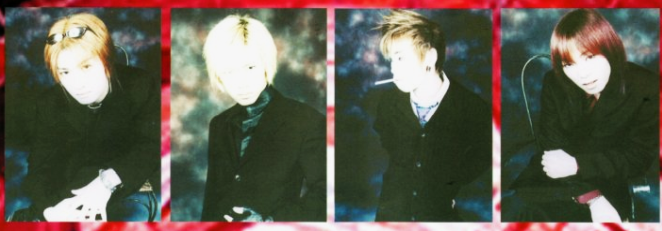
(SEPHILA, with Jun on the far left)
- In 2002, SEPHILA had a major lineup change, leaving the group a duo. What was the reason for their departure?
- The shared future image of SEPHILA and further musical goals became pretty different, so they decided to leave.
- Shortly afterwards, SEPHILA disbanded. What was the reason?
- I think the group folded because I, the main composer of SEPHILA, decided to leave, and the fundamental musicality of the band collapsed thereafter.
- Your next band is a mysterious band named HYPER CRUNCH. Can you tell me a bit about that band?
- HYPER CRUNCH was a band that consisted of myself and other musicians from around the Nagoya area who were also in bands that split right around SEPHILA did. It was intended to be a departure from the typical visual kei sound, but it ended up dissolving pretty shortly after it started.
- After HYPER CRUNCH split, you joined 404NOTFOUND, which also had Akito (陽斗) from meth. on vocals. 404NOTFOUND was a non-visual band, so what inspired you guys to go in that direction?
- 404NOTFOUND was formed by myself and guitarist Tomoking and bassist Ryouji (リョウジ), whom I have known since SEPHILA as they were former members. I think I just wanted to jump towards a new genre.
- 404NOTFOUND managed to garner some attention from overseas listeners. How did you guys respond to that?
- 404NOTFOUND participated in many tours in Korea and other countries, which made our overseas audience increase gradually. We were always aware of that market and always tried to target it.
(404NOTFOUND, with Jun in the middle)
- After 404NOTFOUND disbanded, you appeared to have disappeared from the underground music world. Is that true? And if so, what made you decide to retire for a few years?
- The thing was my mentality was always in the frame that if I was going to do a new band, it would have to surpass all of my other bands one way or another. I chose to use a few years to scope around the underground and prepare, but I never thought about fully retiring.
-
In 2015, SEPHILA reunited for one night only and performed live with all the members for the first time in over 10 years. How did it feel to play together with the guys after such a long time? - There was never any bad blood between us, and we actually knew each other since high school, which is where SEPHILA was formed. I always wanted to do a reunion with SEPHILA if given the chance, so I was able to enjoy it from a pure sense.
-
In 2018, SEPHILA temporarily reunited for a few lives. What prompted a longer comeback?
- After the revival in 2015, I thought it went really well, so we decided to play a few more lives in 2018.
- In 2019, you formed シキ-siki- with not only Akito (陽斗), but with SEPHILA drummer Shoji (将治). What are the future plans with シキ-siki-?
- Currently, シキ-siki- is on hiatus due to conflicts within the personal lives of some members, which was exacerbated by the COVID19 pandemic. We’re not thinking about disbanding at all, so I’d like to continue the band’s activities as soon as possible.
- Thank you very much for your time. Is there anything else you would like to say?
- Thank you very much for the interview. I will continue to be a guitarist for as long as I live, and I hope that with the future activities of SEPHILA and シキ-siki-, you will continue to support me!
(Jun today, as a member of シキ-siki-)
#013 - Kazunori Akihara (秋原和教)
Famous bands: SEPHIROT, SHONEN KAMIKAZE (少年カミカゼ)
- Not many people know that you were a visual kei bandoman before SHONEN KAMIKAZE (少年カミカゼ). What inspired you to become a visual kei bandoman all those years ago?
- I was lent the EXTASY SUMMIT '91 (エクスタシーサミット91) VHS from one of my friends, and when I experienced LUNA SEA… this is the only way, I thought. I was absolutely mesmerized by INORAN’s coolness, and the spinning around during “PRECIOUS”. Another figure that inspired me to become a visual kei bandoman was Kirito (キリト) from PIERROT. Eventually meeting him was a dream come true!
- Can you tell me about your first band, AQUA?
- It was a cover band that played songs from GLAY and SOPHIA when I was in high school. Eventually, we started doing original songs that were composed by leader HIDEKI. It was so much fun. I was the guitarist.
- Your next band, SEPHIROT, received much coverage in the legendary visual kei magazine SHOXX. How did you feel about that exposure?
- I was still in my teens at the time, so I was simply overjoyed to be regularly published in a magazine that I strongly admired. Because of the SHOXX exposure, I received many fan letters too (lol). It was an era where everyone loved visual kei.

(SEPHIROT, with Kazunori on the second-to-left)
- I saw that you eventually left SEPHIROT. What caused you to leave?
- SEPHIROT had a dark sound and image, but I personally was more inspired by softkei and pop music. I just didn’t feel like I fit the image.
- Your next band, TRIC STER ROJIC▼, was indeed a far-cry from SEPHIROT in practically every sense, a total softkei band. What inspired you to finally make that bold jump?
- It was completely and utterly influenced by SOPHIA (lol). SOPHIA was another band that completely changed my life.
- Your last band before SHONEN KAMIKAZE (少年カミカゼ), PR@ZMA, seemed to have a very short run. Can you tell me a bit about it?
- In retrospect, I feel it was a sort of preliminary stage for SHONEN KAMIKAZE (少年カミカゼ). This band was also particularly inspired by the oshare movement, as I was a huge fan of baroque at the time. I lived in Tokyo at the time, so that’s where PR@ZMA was based, although I moved back to the Kansai area afterwards.
- SHONEN KAMIKAZE (少年カミカゼ) was your first non-visual band. What inspired you to retire from the scene?
- Well, put it like this: if you leave visual kei and form your first non-visual band which goes major after about a year of activity, you kind of come to the conclusion that visual kei just isn’t for you (lol). I love the scene, but it just wasn’t a fit for me, I guess. I’d love to reenter the scene at some point though.
- As you said before, SHONEN KAMIKAZE (少年カミカゼ) quickly became a major band, signing to Victor Entertainment. What was it like breaking into the mainstream?
- Yeah, we were major practically instantly, so I don’t think we experienced any hardships or anything yet. I was wondering at the time if being major was actually happening. Life definitely changed from that point on.
- What caused SHONEN KAMIKAZE (少年カミカゼ) to disband initially?
- Hmm… that’s tough. I wonder what caused it too (lol). It was a very rare, blessed debut that went really smoothly, so I’m not really sure.
- What was the inspiration to SHONEN KAMIKAZE (少年カミカゼ) reuniting?
- Maybe somewhere deep down, I felt like there was something that was left unfinished in that band.
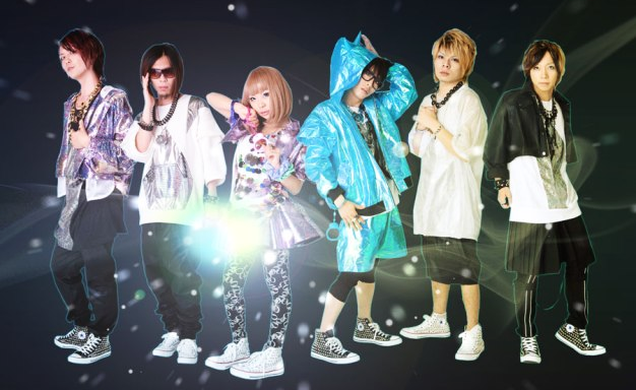
(SHONEN KAMIKAZE (少年カミカゼ), with Kazunori third-from-the-right)
- What is the current state of SHONEN KAMIKAZE (少年カミカゼ)?
- Last year, I was on a tour called AVENZERZ!!, and I performed some SHONEN KAMIKAZE (少年カミカゼ) songs, with some members of SHONEN KAMIKAZE (少年カミカゼ) participating. I was very happy. Everyone was waiting for me after the show, and I almost cried. In fact, I think I might have cried. Next year is the 20th anniversary of SHONEN KAMIKAZE (少年カミカゼ), so I hope we can do something, but who knows (lol).
- Can you please tell me about your current activities?
- Right now, I am in a unit with vocalist CHiYO called CHi+KAZZ. Our concept is stylistic future-pop. We have recently released our first PV, so please check us out.
- Thank you very much for your time. Is there anything else you would like to say?
- Music is the best. I will do my best to make better and better music. Like a ramen shop, I am always serving!

(CHi+KAZZ, with Kazunori on the left)
Check out the first PV of CHi+KAZZ, “MAGICAL DANCE”!
#014 - YOSHITAKA
Famous bands: SMOKY FLAVOR
- How did you first become interested in visual keI?
- One of my older friends in high school went to a local cultural festival and was hugely influenced by the scene, and he brought it to my attention.
- Your first visual kei band was ALLIGATOR back in 1991. What inspired you to join the visual kei movement when the scene was still young?
- A local friend (ALLIGATOR guitarist TAPPEI) invited me to Tokyo, and when I came, we just decided to form ALLIGATOR.

(ALLIGATOR, with YOSHITAKA in the upper-middle)
- Around early 1993, ALLIGATOR disbanded and SMOKY FLAVOR was formed. What caused ALLIGATOR to disband?
- Musical differences, really. I wanted to do more of a metal sound, and I chose to leave and start another band (SMOKY FLAVOR) with some friends of mine at the time.
- Since practically the beginning, SMOKY FLAVOR has always had a rather hectic schedule. What drove SMOKY FLAVOR to have such a crammed schedule, compared to other early visual bands?
- We made friends easily when we toured, so whenever a local band friend would reach out to us, we would be there to play a live, alongside normal touring.
- In 1997, after a dozen demos and singles, SMOKY FLAVOR suddenly went on a brief hiatus. What was the reason?
- SMOKY FLAVOR had underwent a rather intense lineup change, and rather than immediately continuing on, I decided to do some solo work and take my time to find the right members.
- In 1999, along with SMOKY FLAVOR, you started a few more other projects: Psycho-nizm and Dokudoku Monsters (毒々モンスター). With SMOKY FLAVOR already having a tight live schedule, did the busyness of all of the projects ever get overwhelming?
- Rather than taking on a direct role as leader in SMOKY FLAVOR, I would try to leave it as more of a band decision, while simultaneously releasing some of my creative output in the other projects as well. But when members clashed and different views were discussed, I would then get the most stressed.
(SMOKY FLAVOR, with YOSHITAKA on the upper left)
- In the 2000s, although SMOKY FLAVOR had already been around for over a decade, the group seemed as popular as ever. How do you think SMOKY FLAVOR maintained its popularity throughout the massive changes in the visual kei landscape?
- I think that even though we moved to our own pace, the fact that SMOKY FLAVOR remained a resilient force that wasn’t influenced by any of the modernism in VK and stayed true to ourselves is what made us remain popular.
- In 2010, SMOKY FLAVOR disappeared and Animal-Z was started. What was the concept of Animal-Z?
- The concept of Animal-Z was to create a unit that was enjoyable regardless of form.
- Needless to say, SMOKY FLAVOR and Animal-Z are two bands with completely different ideologies and styles. Was it difficult to separate the polar opposite personalities of SMOKY FLAVOR and Animal-Z?
- Aside from SMOKY FLAVOR, I felt Animal-Z would attract artists that were not strictly musicians and create a new vibe, so in that aspect, I’m not sure if I consciously separated the two. Either way, it was a fun time.
- SMOKY FLAVOR, which returned for a few years afterwards, disintegrated again and still currently seems to be on a mysterious hiatus. What happened, and is there a future with SMOKY FLAVOR?
- I think what happened was that I just didn’t have the drive to keep doing SMOKY FLAVOR. I haven’t decided on whether or not SMOKY FLAVOR will return, but I think if it does, I’ll have to really be dedicated.
- You are currently still active as a veteran in the visual kei scene after 30 years, which is an amazing feat! Not many visual kei musicians have stayed around for that length of time. During all of these years, as visual kei changed and evolved numerous times, did you ever feel lost in the matrix and trend of things?
- I think that surroundings of any genre or style will naturally change over time, but I hope the music and performance of a musician in a certain style remains relevant and liked over the course of time. I never really got lost in things, but when I do, I always try to change and adjust slightly.
- Can you tell me a bit about your current project, Yoshigaeru Unit (吉ガエルユニット)?
- Yoshigaeru Unit (吉ガエルユニット) is a solo project of Yoshigaeru (吉ガエル), one of the characters from Animal-Z. The lineup is constantly changing with Yoshigaeru (吉ガエル) being the only core member. Sometimes there are guest vocals though. Overall, I think the music of Yoshigaeru Unit (吉ガエルユニット) is more intense than Animal-Z.
- Thank you very much for your time. Is there anything else you would like to say?
- It’s nice doing music, but one day, I’d like to get married and have a wife! (lol) I remembered a lot of things during this interview and it was fun answering. Thank you.

(Yoshigaeru Unit (吉ガエルユニット), with Yoshitaka as Yoshigaeru (吉ガエル) in the center)
#015 - Hikari Ishitani (石谷光)
Famous bands: BILLY & THE SLUTS, Acma
- How did you first discover visual kei?
- Well, my first encounter with music overall was taking violin lessons as a kid, which started when I was 4. In 6th grade, I moved to England for a year, which is when I discovered rock music. When I returned to Japan a year later, I learned to start playing guitar, and then started my first band soon after. By the time I got into high school, the Japanese metal scene was really starting to boom, and visual kei came from that.
- In 1992, you joined BILLY & THE SLUTS. Was this your first visual kei band?
- In terms of wearing makeup, my first makeup band was in high school with my band ARES. After that, I joined my first visual kei-esqued band KISS THE CRACK with MAY on guitars and YUKARI on drums, both of which would later join THREE EYES JACK. A few years after KISS THE CRACK split, I auditioned to be a member of (BILLY & THE SLUTS), and through the encouragement of my teacher OKA (from DIE-KUSSE), I passed and joined.
- BILLY & THE SLUTS were one of the most popular underground visual bands during the genre’s early days. How did it feel to be a significant part of it?
- At that time, I was totally absorbed to the fullest. I think it was a true blessing how (BILLY & THE SLUTS) got to tour all over the country with fans waiting for us wherever we went.
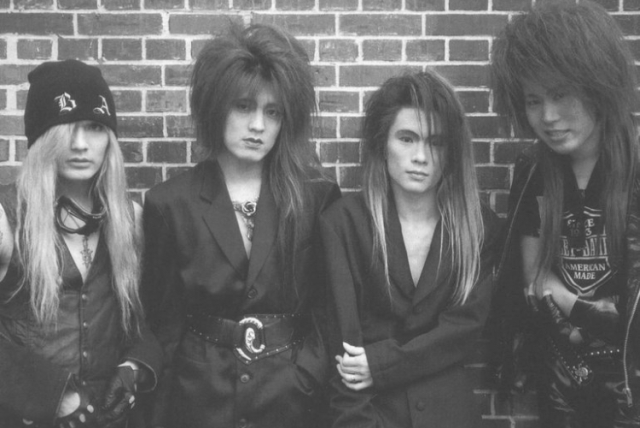
(BILLY & THE SLUTS, with Hikari third-from-the-left)
- In 1996, BILLY & THE SLUTS disbanded. What caused the initial breakup?
- I think it was due to musical differences on where to go. I would then leave. As I started to grow and learn as a musician, I wanted to start doing music that wasn’t limited to the framework of a band’s style or image. After several lineup changes, BILLY & THE SLUTS started to gradually go into a musical direction more akin to funk, and that’s just not the kind of style I wanted to do.
- Before BILLY & THE SLUTS disbanded, you formed another band, NA-ZE?. Was it originally a side project, or was it always a full-fledged band?
- At first, NA-ZE? started as a side project with (vocalist) DAI, and we soon after did a demo tape. After a while, the demo began to attract the attention of some major labels, and we then started to do lives with drummer KARSUKE, who I knew from BILLY & THE SLUTS, and bassist SHINJI. They were originally support musicians, although they would eventually end up officially joining NA-ZE? in early 1996, and it then became a full-fledged band after that.
- In late 1996, NA-ZE? became a major act and signed to Horipro (ホリプロ), although I’ve seen reports of the band having serious issues with the label. Can you discuss some of the issues?
- At first, me and NA-ZE? had a pretty good relationship with Horipro (ホリプロ), although things didn’t exactly come out the way they were supposed to. There was then a change in management at the label and one of the heads of the label pulled me aside and thought it would be a good idea to have NA-ZE? go more towards a folk sound. So NA-ZE? left Horipro and became indies again. Looking back now, I can understand the position the label was in, and there are many things I regret about myself from that time (lol).
- In the summer of 2000, NA-ZE? announced it was going on an “indefinite hiatus”. What was the reason?
- Musical differences. KARSUKE and SHINJI wanted to go more towards an alternative rock direction, but it wouldn’t match the vocal style of DAI. So I decided to split my musical endeavors in two: DH and brain drain (which would later become Acma).
- What did DH stand for?
- The origin of the name of DH was DAI and Hikari (lol).
- DH was very heavily influenced by R&B, which is something that was and still is very rare to find in a visual kei band. Where did that unique sound come from?
- DAI really liked R&B at the time and was good at singing it, so I wanted to make music that would suit that vocal style well. With the help of a DJ friend of mine who had just returned from London at the time (TAKA BOON), DH would perform a few lives as well over the next few years.
- What caused DH to eventually split?
- Basically, once Acma’s activities really started to pick up, I decided I would rather focus more closely on that project, so DH then folded as a result.
- Compared to the previous bands in your timeline, Acma had a sound that image that was distinctly non visual. Was this an intentional move to retire from the scene? If so, why?
- Acma was strongly influenced by UK rock, rooted from my days in London back when I was in the 6th grade. I never intentionally sought to distance myself from visual kei, it just sort of happened naturally.
- Alongside Acma, you also temporarily were a member of RaFF-CuSS. What caused you to leave that group?
- I really hit it off with (bassist) Kouji Fukao (深尾幸治), and we then decided to make music at my house, which became RaFF-CuSS. A few years later, Kouji (幸治) told me that he wanted me to quit Acma and put all of my heart and focus in RaFF-CuSS, which I couldn’t do, so I quit RaFF-CuSS.
- Although Acma was not a visual band, it still ended up being a massive underground crossover success. How did it feel to maintain such deep rooted popularity for the first time outside of the visual kei scene?
- I was really happy that I was able to get such strong support with Acma while I was active with my own musical commitment through trial and error. Starting with “Circusy”, which was included in Acma’s second mini-album, 2002’s “HO-K COMPUTER”, I have also been in charge of theme songs for many professional wrestlers and units, so I think that also helped spread Acma’s popularity wide.
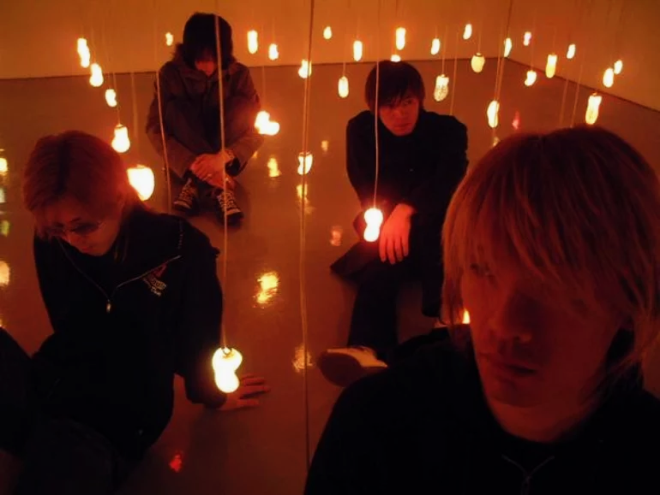
(Acma, with Hikari on the far right)
- Around 2017, Acma seemed to go on a hiatus, which it still appears to currently be on. What happened?
- Well, the band went on a hiatus because of a significant member change which effected composition, and lives were then halted as well. Sometimes though, I’ll use Acma as an alias for composing different songs for wrestlers.
- In 2008, BILLY & THE SLUTS was revived. How did it feel to go back to your roots as a visual kei musician and reunite with the band after all this time?
- It was a fun reunion. The tempo of some songs was faster than I remembered, so the phrasing was a bit difficult at times, but it was still fun! (lol)
- Around 2020, BILLY & THE SLUTS appeared to go on a hiatus. What happened and is there a future for the band?
- Everybody became busy with their own lives and work outside of the band, so things kind of fell apart. But we were approached a few months ago by the band THE BLACK LILLY, which is the new band of DECAMERON vocalist Naoki and drummer Take who we’ve known for years, to play live with them. It’s been a long time since BILLY & THE SLUTS played live, so I’m really looking forward to it.
- Currently, you are mainly working as a songwriter and producer, most significantly working with idol groups. What made you head in this direction?
- It all started some years ago when Naoki (vocalist of SAY-LA and READY) approached me about making an idol group together. I always enjoyed idol pop, so I agreed, and I found that I was able to write idol pop songs quite naturally. The idol group ended up also being named SAY-LA, due to Naoki’s insistence (lol). Since 2011, I’ve been writing songs for SAY-LA, while Naoki has been designing the costumes. Whenever I organize oneman lives for SAY-LA, I also fill in on guitar.
- Thank you very much for your time! Is there anything else you would like to say?
- First of all, I would like to thank everyone who has been involved in my music activities. There have been a lot of fun times and certainly a lot of hard times, but looking back, all of them are treasures. And I want to increase those treasured moments from now on. Also, as I wrote earlier, on Sunday, August 13, 2023, BILLY AND THE SLUTS will be performing at the Shimokitazawa ReG venue for the first time in a while with THE BLACK LILLY. I’m looking forward to seeing old friends, and it’s been a long time since I’ve done a live show with (BILLY AND THE SLUTS), so I hope you can support me. Thank you very much!
(Hikari from a few years ago, promoting the latest SAY-LA release)
#016 - Yasuaki Miyaji (宮路ヤスアキ)
Famous bands: RONDE, Bye2regret
- What first got you into visual kei?
- I first became familiar with the scene through X JAPAN, and I then started following the indies scene closely afterwards.
- Your first visual kei band was RONDE, which blew up in popularity practically overnight. What was it about RONDE that you think made it so popular?
- We were actually still high school kids when we formed RONDE, so we didn’t know what it took to break through the visual kei scene. I think it was just dumb luck.
- In 2000, RONDE signed to Plug Records, a label that had other popular visual bands like Vivid and Psycho le Cemu. What made that label so appealing to you guys?
- RONDE was working hard out the gate to cover band expenses, so I think that just having that particular field covered instead of doing it directly was the most appealing part (lol).
- RONDE was one of the most popular softkei bands. What was the environment like during the softkei boom, versus just a few years later when the scene virtually dissolved?
- Around the time softkei declined in popularity and dissolved, many new visual kei subcategories was started, thus further diversifying the scene. I think that at the end of the day, every genre had its own fads which come to a close, and that bands in that particular boom will come and go in popularity as the subscene does.

(RONDE, with Yasuaki second-from-the-left)
- In 2003, despite still being very popular, RONDE disbanded. What was the reason?
- Some members of the band just got tired of the whole lifestyle, and from the formation, it was decided that if a member left, the other members of RONDE wouldn’t replace them and instead disband.
- After RONDE split, you formed Bye2regret with the vocalist of RONDE, Tomonori Okada (岡田智徳). What were the immediate differences you guys set to do to separate RONDE from Bye2regret?
- We decided that Bye2regret wouldn’t have the same flashiness of RONDE.
- Right before Bye2regret initially disbanded, you joined THE HUSKY, which was your first non-visual band and had Whiteberry vocalist Yuki Maeda (前田由紀). How did you first meet her and the rest of the band?
- The band was formed by (drummer) LEVIN, and when he heard that Bye2regret was in its final days, he reached out to me to join. After that, he sought a female vocalist and reached out to Yuki, and that’s when THE HUSKY started.
- In late 2008, you left THE HUSKY. What was the reason?
- Someone in the band (sidenote: probably Yuki or LEVIN) had trouble with our bassist (Sunao Nakamura (中村すなお)), and asked me personally to fire him. However, I wanted to do more music with him, so me and (Sunao) decided to leave THE HUSKY instead.
- Afterwards, you joined the second lineup of Indigo7. What was it like meeting the other members?
- I actually knew KENT and Yuji Kitadai (キタダイユウジ) from our earlier bands, and I met the other members after I joined. It was a smooth introduction.
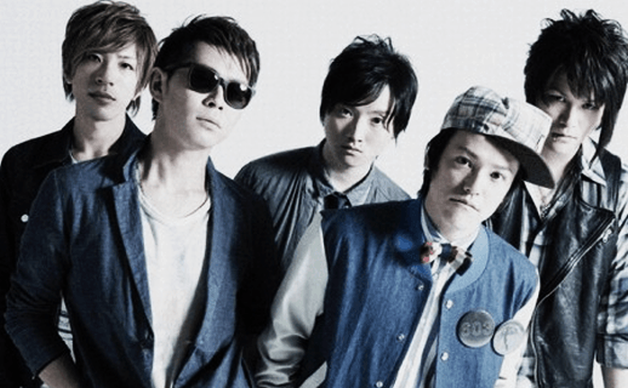
(Indigo7, with Yasuaki on the far right)
- I read that in 2013, Yuji Kitadai (キタダイユウジ) suddenly vanished from the group, thus leading to Indigo7 to disband. Is that true?
- Yes, it’s true. After he left, our agency and the remaining bandmates tried to keep the band going by looking for a replacement, but it was never found, so Indigo7 then disbanded.
- In 2014, you joined D4C, your first visual kei band since Bye2regret’s initial disbandment. How did it feel to return to the scene?
- Now, I don’t have any real hostility towards the scene, but back then, I was really resistant against the idea of wearing makeup and visual kei clothing again. I was actually the only member of the band who was that strongly against it (lol).
- In 2016, Bye2regret reunited, except with very little of the same softkei aesthetic it originally had. Other than stylistically, was there a significant difference between the two eras?
- Other than the new members, not really. But if I had to say, maybe there’s a slight difference in the mindset. For example, originally, my mindset was using the band to continue my journey as a musician. But upon the revival, it changed to seeing the band as more of a hobby where friends get together and make music. I hope that makes sense (lol).
- In 2021, Bye2regret folded for a second time. What was the reason?
- Well, in March of 2021, my father passed away, and because of that, I didn’t really feel like continuing in something that I only saw as a hobby. Plus, the members of the band were getting older and had families, and our visions for how we saw the band became more and more different. Compounded with the COVID19 pandemic, it just seemed like a natural end to the band.
- What are your current musical activities?
- My main job today is working as a composer, arranger and recording engineer. Aside from that, I’m also a support musician in Ash Berry and BAKU BAND.
- Thank you very much for your time. Is there anything else you would like to say?
- It was a great opportunity because I don’t really get too many chances to reflect back on my life and career like this. Thank you very much!
(BAKU BAND, with Yasuaki on the far left)
#017 - Ryo
Famous band: TAI:LEN
- What first got you interested in visual kei?
- Before visual kei was a thing, I was a long time fan of Japanese metal and hard rock from around elementary school, and over time, I began gradually drifting towards bands with a strong focus on their visuals (DEAD END and Seikima-II (聖飢魔II), for example), so I think it started from there.
- Your first visual kei band was TAI:LEN. What did the name mean?
- It came from a slang word in Kagawa-ben, which meant “unbearable”. Because TAI:LEN sounds similar to the slang, I decided that would be our band name.
- It took only 3 years for TAI:LEN to reach the top of the early visual kei underground. How did it feel to be in such a popular band?
- When TAI:LEN were active, livehouses were always packed when we would play, so it was a huge honor!
(TAI:LEN, with Ryo third-from-the-left)
- I saw that TAI:LEN disbanded as a result of the Great Hanshin earthquake. What specific impact did the earthquake have on the band?
- To be exact, because of the earthquake, TAI:LEN decided to move activities to the Tokyo area. But life in Tokyo proved to be pretty hard, with a sharp divide among the band members, as well as with management and producers. As a result of all of these problems, finances became dire, so we then decided to disband.
- After TAI:LEN disbanded, you appeared to have retired from visual kei. Is this true? If so, what caused you to retire?
- It’s true. I ended up deciding on a route that would directly support my family, and as a result, I stopped my musical activities for nearly 20 years.
- In 2012, TAI:LEN reunited after 17 years apart. How did it feel to reconnect with the band members and returning to the scene after all those years?
- It was my first musical activities since retiring all those years back, so for that alone, it was special. I had many thoughts in my head and me and the rest of the members apologized to each other and made amends. It was really moving.
- In 2017, TAI:LEN dissolved again, and I see that you then decided to open a crepe shop. Can you tell me a bit of the journey from returning to the scene to opening a crepe shop?
- The guitarist of TAI:LEN, AKI, didn’t have a regular job at the time, so me and him discussed on opening a crepe shop, and that remains our current main source of income.
- Do you think you will ever return to music again? Either with TAI:LEN, or something else?
- Unfortunately, I don’t really have too much time these days to do music, but the personal relationships between me and the other members of TAI:LEN is still really good today. I would like to return with TAI:LEN sometime in the future if the opportunity arises.
- Thank you very much for your time! Is there anything else you would like to say?
- I am thrilled that TAI:LEN is still remembered after 30 years. Thank you.
(Ryo, today)


